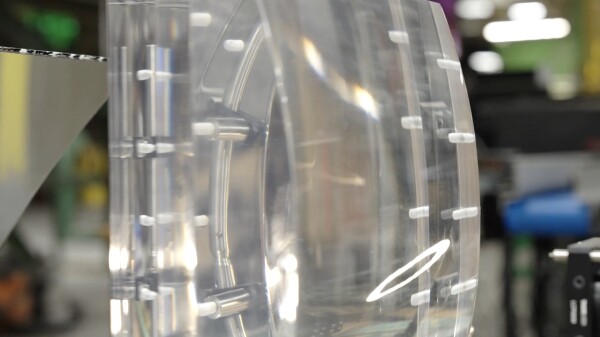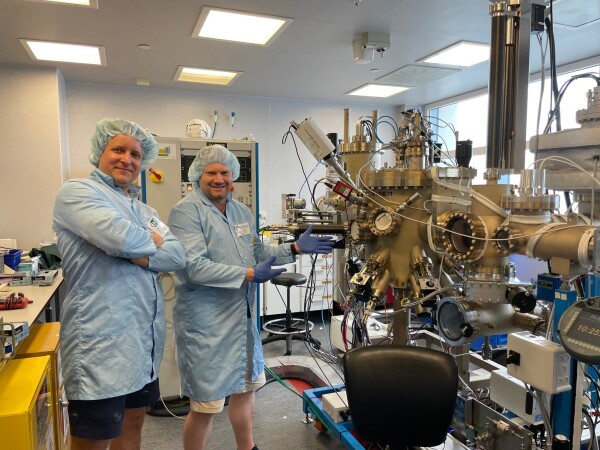Turning Waste into Wealth
12 March, 2025
‘Recycling less than 10% of plastics is a disaster for the planet. And yet plastics recycling is a tremendous business opportunity worth trillions of dollars.’
This is the view of Professor Alexander Friemann Dmitriev, a self-described ‘super nerd’ who has co-founded startup company NeoSort using nanotechnology, new optical sensing tech, and AI, to sort plastics for recycling. The company already has a large prototype demo facility in Toronto in Canada, investment of 20 million US$ and is currently in a multi-million US$ fundraise round.
Alexander (who is Professor of Physics at the University of Gothenburg in Sweden and a Head of Department of Physics there), says that 10-13% of global CO2 is emitted by the production of new plastic and that more than eight million bits of plastic enter our oceans every single day.
‘And yet the microplastics and other plastics in the ocean has value as a material. So how do we extract it? How do we sort? How do we produce clean materials?’
He says one of the problems has been that different types of plastics can be quite different to each other chemically – they’re not uniform.
‘This is why recycling plastics together is extremely difficult, even burning it is a problem as they melt at different temperatures. If plastics cannot be sorted, they’re unusable.’
‘And yet the microplastics and other plastics in the ocean has value as a material. So how do we extract it?'
For proper recycling, plastics must first be separated, a process that is both time-consuming and expensive. Which is where his new tech comes in.
‘Recycling of pure materials per se is doable but sorting certain plastics, even as simple as bottles from PET, can be hard - even these only reach about 70% efficiency. Recycling has to be 100% clean. The end product can’t have even the tiniest impurity.
‘We’re sorting these materials with as high accuracy as physically possible, with identification itself hitting close to 100% accuracy. We’ve achieved detection speed equivalent to detecting 25 tons per hour, enabling us to scaleup and meet waste processing demands of any city, and we’re aiming to hit 250 MHZ detection frequency i.e. 250m readouts per second.

He says the business model is that sorting facilities provide clean materials back to producers.
‘The moment you can assemble clean piles of materials you can sell to whoever wants to buy it. It has a value not matter wherever you are in the world.’
And while the path from IP to a multi-million-dollar demo plant seems fast (it’s only been five years since their first patent was submitted), he’s quick to stress that the science and knowhow behind the IP is based on decades of solid fundamental science.
‘While it looks quick, the R&D underpinning the company has all come out of Sweden and it’s all based on 15-20 years of fundamental research in nanoscience, optics, sensors, and signal processing,’ he says.
‘Our technology was named one of top 100 Swedish Innovations 2023 by the Royal Swedish Academy of Engineering Sciences, and then last summer we created NeoSort as a US company. We’ve built a big prototype demo in Toronto. ‘
He says sorting black plastics is traditionally hard cause the conveyor belt is also black, plus black absorbs the light traditionally used in spectroscopy to identify materials.
‘Our technology involves spraying small amounts of nanosensors onto the plastic to enhance the interaction of light with this material'
‘But our process can distinguish black plastics with close to 100% accuracy cause the colour or material doesn’t matter. It can be metal, it can be cardboard, it can be anything.
‘Our technology involves spraying small amounts of nanosensors onto the plastic to enhance the interaction of light with this material. Conventional spectroscopy lacks the scanning speed required in sorting industry, but we’ve reinvented optical spectroscopy to push it to millions of scan per second and then added in the advanced machine learning. The nanosensors is new engineering.
He explains there are three aspects to the science:
‘Firstly there’s the nanosensors aspect – which is based on the 20 years of fundamental science. But we had to figure out how to apply them to the plastics. We don’t want them to clump. We can’t overspray, and we also don’t want the plastic contaminated by the nanosensors.
‘Secondly – the optics and mechanics together – we invented a new approach. But as with nanosensors we didn’t publish. We went straight to patent.
‘And lastly the AI, which is essential to this.’
With nanosensors he says they’ve turned the ‘sensor chip’ idea upside down.
‘Instead of having a ‘chip’ or ‘sensor’ that you might pass something through or over (to test blood for sugar, specific markers or test for COVID for example), we’ve made the material a target for the chip – like an active tag on the material – we put actual sensors on the plastic. This concept has been developed for the past 10-15 years – but we’ve turned it back to front, turned it upside down. Like a ‘sensing QR-code’ which changes as it senses the properties of material.’
And it’s all go.
‘We’re planning to be signing sales contracts later this year. The next machine will be much bigger.
‘This isn’t science any longer, it’s advanced engineering,’ he says.
He says the nanosensor size is critical to the technology.
‘The nanosensor size allows for the concentration of light – we’re squeezing light into the nanometre scale, creating tiny lenses like antennae. And this light squeezed into a small spot identifies the material.
‘The principle is very simple.’
Alexander has been connected with NZ through longtime collaborations with University of Auckland based MacDiarmid Institute Principal Investigator Associate Professor Jenny Malmström, and through being a former Erskine fellow. He is also a partner (with Jenny and fellow MacDiarmid Institute Principal Investigator VUW RRI researcher Dr Simon Granville and University of Newcastle Associate Professor Karen Livesey) on a January 2024 Catalyst Seeding grant through the Royal Society, and was here in New Zealand last month collaborating with Jenny and Simon. Alexander says the project ‘Light-driven science and technology enabled by magnetic materials at multi-scale’ that they’re running with optical nanoantennas is based on the same principle fundamental nanoscience that is used in NeoSort.
‘We’re trying to formulate hierarchies of materials with new functionality, connecting chemistry and magnetism and light all together all at the same time,’ he says.

Professor Alexander Dmitriev with Dr Simon Granville in the VUW cleanroom lab
‘We’re trying to formulate hierarchies of materials with new functionality, connecting chemistry and magnetism and light all together all at the same time'
He says Simon’s expertise in magnetism and light, Jenny’s expertise in chemical processing and nanotech of soft matter, Karen’s expertise in theoretical modelling of magnetic nanomaterials and his own expertise in nanofabrication and scale-up, is a ‘perfect mix of people with the right overlap but representing different fields’.
‘We’re clearly doing different things and with synergy might create something new.
He says there’s been a real aspect of serendipity in the creation of NeoSort.
‘In 2020 Europe’s Horizon programme invited me into a discussion forum with industry about reducing emissions of greenhouse gas. It wasn’t my normal academic forum, but I said yes. I was keen to hear what people thought. Discussions led us to a company that was making advanced servers – electronics – in Switzerland – and then this led to conversations about recognising materials in recycling.
‘Industry were mind blown at the ability of our nanosensors, and everything quickly escalated,’ he says.
‘The common denominator in all of this is that I didn’t say no to opportunities. Sure it probably didn’t boost my research career but that’s okay cause I’m concerned about the environment and the state of the planet, and I wanted to see what the businesspeople in the group were thinking about. It’s a story of connections.’
‘And then after failing several years in our applications for government funding, we thought – why don’t we just do it ourselves?’
‘The problem of plastics connects to everyone. It’s one of the critical problems humanity is actually facing.
‘We're in alignment. As the waste crisis continues to grow, our never-before-seen tech with its accurate, cost-effective, and rapid sorting and recycling capabilities will be a driving force for change.’
'(this Catalyst Seeding grant) is a perfect mix of people with the right overlap but representing different fields'


